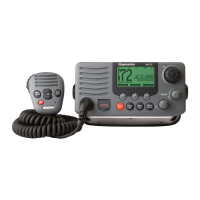
Do you have a question about the Raymarine Ray218 and is the answer not in the manual?
| Brand | Raymarine |
|---|---|
| Model | Ray218 |
| Category | Marine Radio |
| Language | English |
Provides guidelines for antenna mounting to ensure optimal performance and safety.
Explains the DSC functionality and its importance for distress calls.
Offers guidance on selecting an appropriate location for mounting the transceiver.
Details how to connect various cables for power, NMEA, speaker, etc.
Explains the function of keys and knobs on the transceiver and microphone.
Details the functions of individual keys on the microphone.
Describes the function of the CH/OK, PWR/VOL, and SQ knobs.
Explains the functions of the push buttons on the transceiver.
Explains the various indicators and data displayed on the transceiver's LCD screen.
Explains how the radio scans channels for transmissions.
Guides on adjusting transmission power between high and low.
Explains how to temporarily override low power restrictions on specific channels.
Covers Dual Watch and Tri Watch modes for monitoring channels.
Covers operations of the hailer, fog horn, and intercom features.
Covers setting up GPS position and time information.
Covers sending and receiving distress calls.
Guides on initiating distress calls.
Explains sending a distress call without specifying its nature.
Guides on sending a distress call with a specified nature.
Explains how the radio receives and alerts for distress calls.
Covers managing contact entries for DSC calls.
Guides on adding new contacts to the phonebook.
Covers making and receiving individual DSC calls.
Guides on initiating individual DSC calls.
Explains how the radio handles incoming individual DSC calls.
Covers making and receiving group DSC calls.
Guides on programming group MMSI IDs and names.
Guides on making group calls.
Explains how the radio handles incoming group DSC calls.
Covers sending and receiving all ships DSC calls.
Guides on making urgency or safety all ships calls.
Explains how the radio handles incoming all ships calls.
Covers requesting and sending GPS position information.
Guides on selecting the recipient for a position request.
Explains how the radio logs received DSC calls.
Covers configuring DSC settings like MMSI ID and auto channel change.
Explains how to enter and store the radio's MMSI number.
Details enabling/disabling automatic channel changes for calls.
Explains how the radio responds to GPS position requests.
Lists US VHF channels, frequencies, and their uses.
Lists Canadian VHF channels, frequencies, and uses.
Lists international VHF channels, frequencies, and uses.